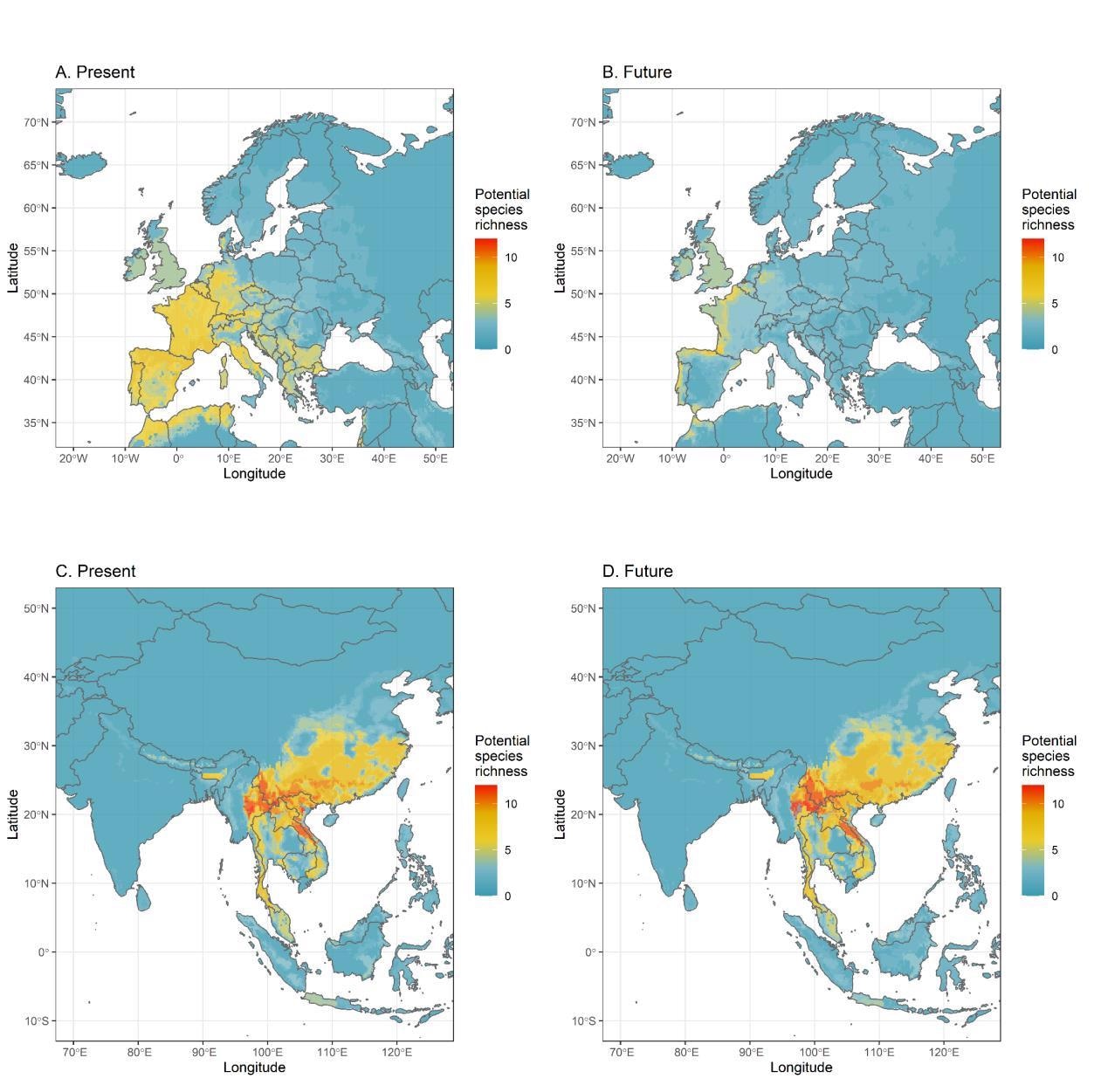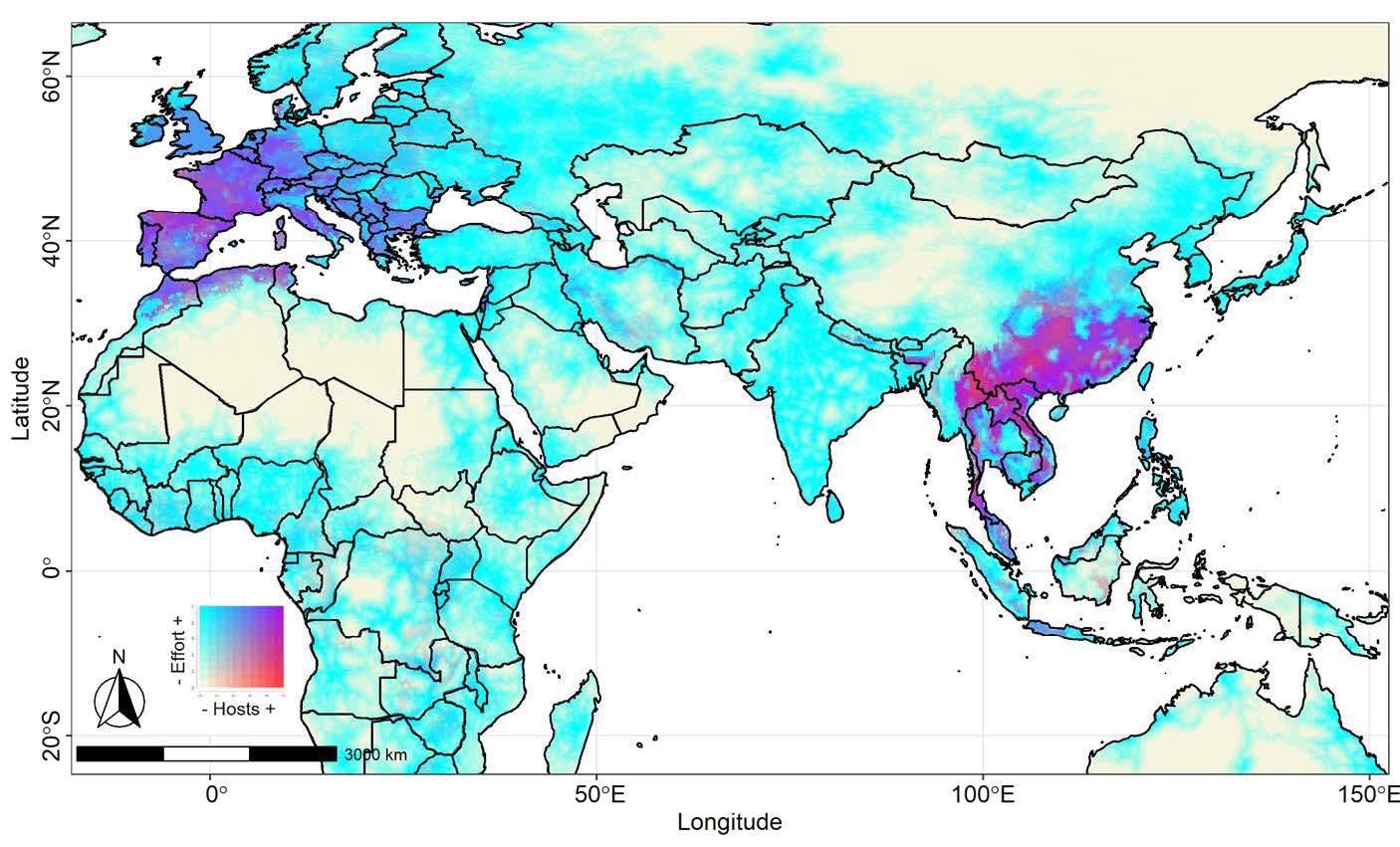Bats may be small, but they are a giant incubator for viruses such as the severe acute respiratory syndrome coronavirus 2 (SARS-CoV-2) that emerged in Wuhan, China, in late 2019.
A new study led by David T. S. Hayman of Massey University in New Zealand details the creation of an ecological modeling pipeline to identify bat biodiversity data and patterns on bat distribution based on climate and landscape relationships.
Global warming and other human-driven habitat changes are expected to alter migration patterns for species, changing the risk of disease from parasites and infections hosted by animals. Bats hosting sarbecoviruses are of particular concern as previous strains such as SARS-CoV and SARS-CoV-2 have caused global outbreaks.
The research team’s current projections suggest bat hotspots are increasing around Myanmar and will move east towards hotter locations in Southeast Asia.
Understanding hotspots for bats hosting sarbecoviruses may help conservationists prevent species extinction and help scientists prepare for another bat to human viral outbreak.
The study “Present and future distribution of bat hosts of sarbecoviruses: implications for conservation and public health” was recently published on the bioRxiv* preprint server before peer review.
 Study: Present and future distribution of bat hosts of sarbecoviruses: implications for conservation and public health. Image Credit: Binturong-Tonoscarpe / Shutterstock
Study: Present and future distribution of bat hosts of sarbecoviruses: implications for conservation and public health. Image Credit: Binturong-Tonoscarpe / Shutterstock

 This news article was a review of a preliminary scientific report that had not undergone peer-review at the time of publication. Since its initial publication, the scientific report has now been peer reviewed and accepted for publication in a Scientific Journal. Links to the preliminary and peer-reviewed reports are available in the Sources section at the bottom of this article. View Sources
This news article was a review of a preliminary scientific report that had not undergone peer-review at the time of publication. Since its initial publication, the scientific report has now been peer reviewed and accepted for publication in a Scientific Journal. Links to the preliminary and peer-reviewed reports are available in the Sources section at the bottom of this article. View Sources
Modeling details
Ecological niche models were used to study the distribution of bats hosting Sarbecovirus. The data incorporates factors such as climate, karst (an area of land made up of limestone), and forest that may affect current and future bat migration.
Along with these factors, the researchers predicted potential shifts in hotspots based on various climate change scenarios.
Study results
A total of 35 bat species were identified as hosts for sarbecoviruses. Mapping across species found bats are likely to congregate in Europe, Indochina, and Central Africa.
The most important predictors for species distribution were seasonal temperatures and cave availability.
Present and future projections forecast the most significant number of bat species will occur in Southeast Asia. Specifically, 13 bat hotspots will be in Myanmar, and 12 species will be in China, Lao’s People Democratic Republic, Thailand, and Vietnam.
 Present (A, C) and future (B, D) distribution of Sarbecovirus bat host species richness, mostly peaking in Europe and Southeast Asia. Projections for Sarbecovirus bat host species richness consider the period 2080-2100 (SSP585 scenario, BCC-CSM2-MR global circulation model).
Present (A, C) and future (B, D) distribution of Sarbecovirus bat host species richness, mostly peaking in Europe and Southeast Asia. Projections for Sarbecovirus bat host species richness consider the period 2080-2100 (SSP585 scenario, BCC-CSM2-MR global circulation model).
However, the researchers note species diversity may decrease in the future because of changing disruptions to ecological habitats.
Some species, such as Hipposideros armiger, Hipposideros galeritus, and Hipposideros larvatus are expected to be resilient to disruptions in forest quality and cave dwellings. However, other bats belonging to Rhinolophus ferrumequinum and Rhinolophus affinis are expected to decrease over time.
When researchers simulated an extreme global warming scenario, the model predicted a loss of habitat range. Although six species may gain more territory, as there will be a decrease in species overlap.
Currently, the average temperature for host hotspots in southeast Asia is 20.6 °C but is predicted to rise to 22.7 °C. With shrinking availability for climate stable forests, the researchers predict that most habitats in the north, especially on the China border, will be lost — further contributing to a reduction in species diversity and richness.
The results suggest the amount of forest available and proximity to rocky landscapes and karst that can make caves and underground streams are crucial in shaping the distribution of bat hosts.
While the researchers did not create simulations based on mining, they note that karst availability may change based on mining and limestone quarrying that reduce karst habitats.
A modeling simulation of high carbon dioxide emissions by 2040 predicts further habitat loss for most bat species. Additionally, increased carbon dioxide levels are expected to move the bat population from Kat Ku Myanmar to denser forest areas surrounding the east of Laos.
 A choropleth bivariate map showing the near current distribution of reported Sarbecovirus bat host species and estimated sampling rate calculated for the filtered dataset, according to potential drivers of residual accessibility bias. Areas in red signal high numbers of Sarbecovirus hosts, but estimated lower sampling rates driven by accessibility.
A choropleth bivariate map showing the near current distribution of reported Sarbecovirus bat host species and estimated sampling rate calculated for the filtered dataset, according to potential drivers of residual accessibility bias. Areas in red signal high numbers of Sarbecovirus hosts, but estimated lower sampling rates driven by accessibility.
Implications for conservation efforts
The increase in carbon emissions and rising global temperatures is expected to limit habitat availability for several bat species. In fact, the researchers note that most species are already in decline.
The findings suggest that plans for reducing climate change, along with strategies for maintaining landscape-level habitat connectivity, are necessary for reducing the risk of extinction for many species.
“This could be done by developing landscape connectivity surfaces that maximize diversity hotspot extensions, with monitoring effective dispersal through genetic and population,” advised the researchers.

 This news article was a review of a preliminary scientific report that had not undergone peer-review at the time of publication. Since its initial publication, the scientific report has now been peer reviewed and accepted for publication in a Scientific Journal. Links to the preliminary and peer-reviewed reports are available in the Sources section at the bottom of this article. View Sources
This news article was a review of a preliminary scientific report that had not undergone peer-review at the time of publication. Since its initial publication, the scientific report has now been peer reviewed and accepted for publication in a Scientific Journal. Links to the preliminary and peer-reviewed reports are available in the Sources section at the bottom of this article. View Sources
Journal references:
- Preliminary scientific report.
Muylaert RL, et al. (2021). Present and future distribution of bat hosts of sarbecoviruses: implications for conservation and public health. bioRxiv. Doi: https://doi.org/10.1101/2021.12.09.471691, https://www.biorxiv.org/content/10.1101/2021.12.09.471691v1
- Peer reviewed and published scientific report.
Muylaert, Renata L., Tigga Kingston, Jinhong Luo, Maurício Humberto Vancine, Nikolas Galli, Colin J. Carlson, Reju Sam John, Maria Cristina Rulli, and David T. S. Hayman. 2022. “Present and Future Distribution of Bat Hosts of Sarbecoviruses: Implications for Conservation and Public Health.” Proceedings of the Royal Society B: Biological Sciences 289 (1975). https://doi.org/10.1098/rspb.2022.0397. https://royalsocietypublishing.org/doi/10.1098/rspb.2022.0397.
Article Revisions
- May 9 2023 - The preprint preliminary research paper that this article was based upon was accepted for publication in a peer-reviewed Scientific Journal. This article was edited accordingly to include a link to the final peer-reviewed paper, now shown in the sources section.